The view will improve in April. Get ready to see the Red Planet at its best as explained in "The Opposition of Mars" from Science@NASA. www.spaceweather.com
|
Earth and Mars are converging for a close encounter in April. It's only March, but the view through backyard telescopes is already superb. Michael A. Phillips of Swift Creek, NC, took this picture using a 14-inch telescope on March 27: In Phillips's picture, south is up. It shows the rapidly evaporating North Polar Cap (summer arrived in February), orographic clouds over martian volcanoes near the equator, and a bright blue cloud filling Hellas Basin in the south. Only an experienced astrophotographer can produce this kind of Hubblesque detail using backyard optics. Novice observers looking through the eyepiece of a small telescope can still see a lot, however, including the rusty-red disk of Mars and bright smudges corresponding to the polar cap and Hellas Basin.
The view will improve in April. Get ready to see the Red Planet at its best as explained in "The Opposition of Mars" from Science@NASA. www.spaceweather.com
0 Comments
On Saturday, March 29th, the magnetic canopy of sunspot AR2017 erupted, producing a brief but intense X1-class solar flare. A flash of extreme UV radiation sent waves of ionization rippling through Earth's upper atmosphere and disturbed the normal propagation of terrestrial radio transmissions. Radio engineer Stan Nelson of Roswell, NM, was monitoring WWV at 20 MHz when the signal wobbled then disappeared entirely for several minutes: "The Doppler shift of the WWV signal (the 'wobble' just before the blackout) was nearly 12 Hz, the most I have ever seen," says Nelson. The flare not only blacked out radio signals, but also produced some radio signals of its own. The explosion above sunspot AR2017 sent shock waves racing through the sun's atmosphere at speeds as high as 4800 km/s (11 million mph). Radio emissions stimulated by those shocks crossed the 93 million mile divide to Earth, causing shortwave radio receivers to roar with static. Here is a plot of the outburst detected by Nelson using a 20.1 MHz RadioJove receiver. Elsewhere, strong bursts were recorded at frequencies as high as 2800 MHz. It was a very broad band event. NASA's Solar Dynamics Observatory recorded a beautiful movie of the flare: The flash you just saw was extreme UV radiation, the type of radiation that ionizes the upper layers of our atmosphere. In this case, the ionizing action of the flare led to a rare magnetic crochet, measuring 17 nT at the magnetometer in Boulder, Colorado.
A magnetic crochet is a ripple in Earth's magnetic field caused by electrical currents flowing in air 60 km to 100 km above our heads. Unlike geomagnetic disturbances that arrive with CMEs days after a flare, a magnetic crochet occurs while the flare is in progress. They tend to occur during fast impulsive flares like this one. The magnetic field of sunspot AR2017 is decaying now, but it still poses a threat for eruptions. www.spaceweather.com "As you gradually attune to your I AM Presence, through each higher level of your OverSoul Self, you will integrate more of the Essence of our Father/Mother God. Then is when your true Divine Self will begin to radiate forth in all its glory. It is happening now, beloveds. You see and sense it in yourself and in many of those around you, as your numbers grow by leaps and bounds. Spirit walks the Earth, beloveds, and it is YOU. Know that you are loved beyond measure. I AM ARCHANGEL MICHAEL" Read the full Archangel Michael channelling here: http://www.ascensionnow.co.uk/celebrating-a-spiritual-reunion.html
A total lunar eclipse on April 15th marks the beginning of a 'tetrad' -- a series of four consecutive lunar eclipses all visible from North America. Get the full story from Science@NASA.
ESO Wed, 26 Mar 2014 11:46 CDT An international team of astronomers, led by Felipe Braga-Ribas (Observatório Nacional/MCTI, Rio de Janeiro, Brazil), has used telescopes at seven locations in South America, including the 1.54-metre Danish and TRAPPIST telescopes at ESO's La Silla Observatory in Chile, to make a surprise discovery in the outer Solar System. This unexpected result raises several unanswered questions and is expected to provoke much debate. A press conference will be held in Brazil to present the new results and allow opportunities for questions. Note that all information regarding these findings is under strict embargo until 19:00 CET (15:00 BRT) on Wednesday 26 March 2014. When: The conference will be held on 26 March 2014 at 14:30 local time (BRT) and will take place in Portuguese with a summary in English. More at: http://www.sott.net/article/276315-Press-conference-in-Brazil-to-announce-discovery-in-outer-Solar-System Chariklo found to have two rings : 26 March 2014 Observations at many sites in South America, including ESO’s La Silla Observatory, have made the surprise discovery that the remote asteroid Chariklo is surrounded by two dense and narrow rings. This is the smallest object by far found to have rings and only the fifth body in the Solar System — after the much larger planets Jupiter, Saturn, Uranus and Neptune — to have this feature. The origin of these rings remains a mystery, but they may be the result of a collision that created a disc of debris. The new results are published online in the journal Nature on 26 March 2014. The rings of Saturn are one of the most spectacular sights in the sky, and less prominent rings have also been found around the other giant planets. Despite many careful searches, no rings had been found around smaller objects orbiting the Sun in the Solar System. Now observations of the distant minor planet (10199) Chariklo as it passed in front of a star have shown that this object too is surrounded by two fine rings. More at: http://www.eso.org/public/news/eso1410/ (CNN) -- For anyone holding out hope of Pluto being reinstated as a major planet, you should probably do as they say in the movie "Frozen" and "let it go." But here's a new exciting find from the far reaches of our solar system: Astronomers have discovered a dwarf planet that's even farther away than Pluto -- so far, in fact, that its orbit reaches into a new edge of the solar system. The dwarf planet's current name is 2012 VP113, and it is located in a "wasteland or badland of the solar system," said astronomer Chad Trujillo, head of adaptive optics at Gemini Observatory in Hawaii and co-discoverer of this object. His study was published Wednesday in the journal Nature. "The big question is, how is this formed? How can you get an object out there?" he said. "We really don't know an answer to that yet." This dwarf planet is unusual because of its orbit, Trujillo said. On its elliptical path, the closest it ever comes to the sun is still very far away from the rest of the solar system. Its full orbit is farther than the orbit of any other object we know of in the solar system. More at: http://edition.cnn.com/2014/03/26/tech/innovation/dwarf-planet-solar-system/ Nicola Jenner, New Scientist, Wed, 26 Mar 2014 A surprise monster may be lurking in our solar system. A newly discovered dwarf planet has grabbed the crown as the most distant known object in our solar system - and its orbit hints at a giant, unseen rocky world, 10 times the mass of Earth and orbiting far beyond Pluto.
The dwarf planet, for now dubbed 2012 VP113 because it was spotted in images taken in November 2012 - is an interesting discovery in itself. Scott Sheppard of the Carnegie Institution for Science in Washington DC and his colleagues found that it is a lump of rock and ice 450 kilometres wide and lies at 80 astronomical units from the sun at its closest approach (1 AU is Earth's distance from the sun). That's twice as far as the most famous dwarf planet, Pluto, which is 2340 kilometres wide and also beats the previous record holder, a 1000-kilometre-wide planetoid called Sedna, discovered in 2003, with a closest approach of 76 AU out. Objects orbiting this far from the sun, in the "inner Oort cloud", are useful to probe the early solar system. That's because they lie too far away to be perturbed by the gas planets, but too close to the sun to be affected by the gravity of other stars in our galaxy - so their orbits and behaviour are thought to be almost unchanged since they first formed. "Once we find more objects in this region, we'll be able to start to strongly constrain the possible formation scenarios," says Sheppard. More at: http://www.sott.net/article/276322-New-dwarf-planet-hints-at-giant-world-far-beyond-Pluto Mars is approaching Earth for a close encounter in mid-April. As the two planets converge, the red color of Mars is becoming increasingly vivid to the naked eye. This is especially true because Mars is located not far from Spica, a blue-giant star of first magnitude in the constellation Virgo. Each evening when Mars and Spica rise side by side in the eastern sky, the red-blue contrast is eye-catching: Astronomy professor Jimmy Westlake of Colorado Mountain College took the picture on March 20th, the first night of northern spring, and labeled it to show not only "ruddy Mars and icy-blue Spica," but also two nearby space rocks.
"This spring, Mars is looping through the stars of Virgo alongside the large asteroids Ceres and Vesta," explains Westlake. "All three reach opposition next month: Mars on April 8th, Vesta on April 13th, and Ceres on April 15th. Vesta, the nearer and more reflective of the two, appears about a magnitude brighter than Ceres. Both are within easy grasp of binoculars." Look for Mars and Spica rising in the east after sunset, around 9 pm local time. A backyard telescope pointed at Mars will show you more than a red dot. Mars's north polar cap, surface features and clouds are being photographed by amateur astronomers around the world as the red planet grows larger in the eyepiece every night. Browse the gallery for examples: Realtime Mars Photo Gallery www.spaceweather.com 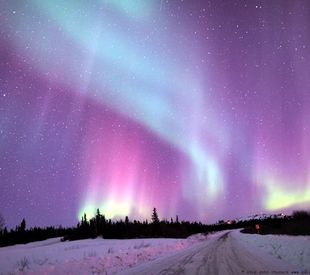 For reasons not fully understood by researchers, equinoxes favor auroras. Around the start of northern spring, even small gusts of solar wind can spark bright lights in arctic skies. On March 21st, John Chumack captured an outburst of spring colors over Alaska: Although solar wind conditions were quiet, "we saw absolutely amazing auroras for 30 minutes outside Fairbanks!" says Chumack. "I took over 450 photos as the lights danced and swayed. It got so bright at times, the snow turned green, red and purple, too." The solar wind remains relatively calm, but at this time of year it doesn't take much to stir up the lights. NOAA forecasters estimate a 20% chance of polar geomagnetic storms on March 23rd. www.spaceweather.com Long ago researchers thought solar flares were isolated events. Magnetic fields above a single sunspot became unstable and exploded--end of story. The Solar Dynamics Observatory's global view of the sun has shown, however, that widely-separated sunspots can explode in tandem. That's what happened on March 20th when AR2010 and AR2014 combined for a double flare: 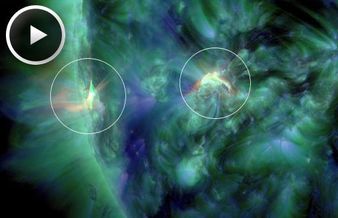 Transparent arcs of magnetism stretching across the 400,000 km divide between the two sunspots allow them to communicate magnetohydrodynamically, so instabilities in one can affect the other. This appears to be a textbook example of a 'sympathetic flare.' The most famous example occurred on August 1, 2010. SDO watched as instabilities jumped vast distances from one sunspot to another, setting off a chain reaction that engulfed more than half the sun. Compared to that global eruption, today's double flare was puny--or as puny as two explosions more powerful than a billion nuclear bombs can be. Welcome to the sun. www.spaceweather.com China's lunar rover, the "Jade Rabbit", is awake and communicating with Earth. The rover had recently hunkered down to survive its third night on the Moon. Mission controllers weren't sure the Jade Rabbit could survive as darkness fell for two weeks and temperatures plunged as low as -170 C. But survive it did, although the rover can no longer move. Stuck in place, Jade Rabbit continues to gather data about its surroundings in Sinus Iridum (the Bay of Rainbows). The mission was designed to last only 3 months, so every byte that comes back now is a bonus. [more] www.spaceweather.com
All of humanity is in the process of realignment. It can be uncomfortable as old perceptions change. But if you watch from the view point of the observer you can clearly see the glorious change that is occurring. Our children will live in a much different world than we do. Judgement of others already seems outdated. It's happening. Do not focus on those who are trying to keep things the same. It is their fear that speaks loudly. We are returning to love. There is only love. ~ Unknown
This Abraham-Hicks recording (5/12/05 Philadelphia, PA ) offers a great explanation of the teachings of Abraham. It's a very valuable audio to share with those who are new to Law of Attraction and/or Abraham-Hicks. All recorded and printed Abraham-Hicks materials are copyrighted by Jerry and Esther Hicks. For more information on Abraham, Esther & Jerry Hicks please go to their website: http://www.abraham-hicks.com/ Neuroanatomist Jill Bolte Taylor had an opportunity few brain scientists would wish for: One morning, she realized she was having a massive stroke. As it happened -- as she felt her brain functions slip away one by one, speech, movement, understanding -- she studied and remembered every moment. This is a powerful story about how our brains define us and connect us to the world and to one another. ) Uploaded on 13 Mar 2008
http://www.ted.com Anandavala
In Sanskrit: Ananda – Bliss : Kevala – Oneness At one with the bliss, the state of being one with bliss, or bliss amidst the oneness. Ananda is implied in the context of: “Sat Chit Ananda” from Vedic Metaphysics or existence, consciousness, bliss or representation, computation, meta-system-transition. These are the three principle constituents of manifest being. It could be said that systems exist (sat) and interact or process information (chit) and thereby evolve toward harmony and integration into collective wholes (ananda). More truthfully there is a field of energy (sat) it resonates and fluctuates coherently (chit) and manifests harmony and unified being (ananda) Bliss is both a precondition and the completion of manifest being, so too is Love. Love and Bliss are harmony; for creation to Be there must be harmony, for creation to evolve to greater heights, there must be Love and Bliss. A world without harmony is a world of sickness, a world of suffering that can only decay into non-Being, making way for new worlds to arise. Only those worlds that manifest harmony may persist, and become the foundation for all future creation. The source of All is One. With bliss the one evolves into many, through bliss the many harmonise as one. Thus creation unfolds. Outwardly Anandavala means: being in harmony with the process of creation, the state of being one with cosmic evolution. Inwardly it means: dwelling in bliss and oneness, each flows into the other. Through bliss there arises oneness, and in oneness there is bliss. www.Anandavala.info |
QUICK INFO
Author:
_Messenger Spirit This section is for interesting items which are brought to my attention but which do not merit a separate article.
I welcome your comments, questions or suggestions on any topics you wish to contribute to this section. Please submit these on the Contact and Feedback Form PLEASE DO NOT SUBMIT COMMENTS ON THE FORM WHICH APPEARS UNDER ITEMS ON 'QUICK INFO'; THIS SYSTEM IS NOT WORKING. Categories
All
Archives
July 2024
|
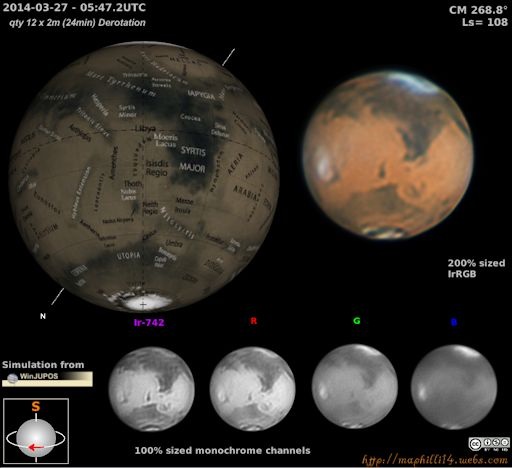
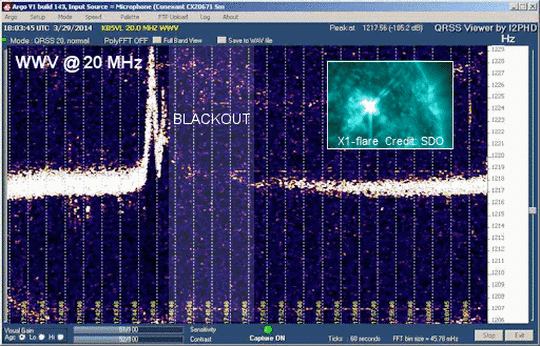
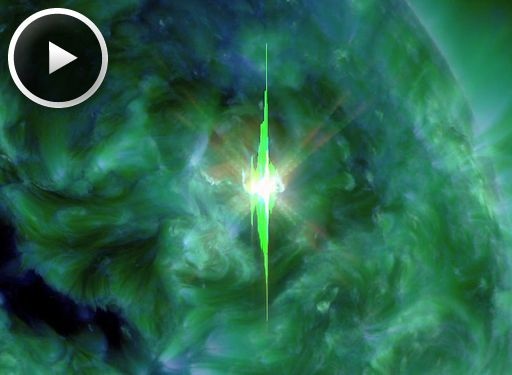
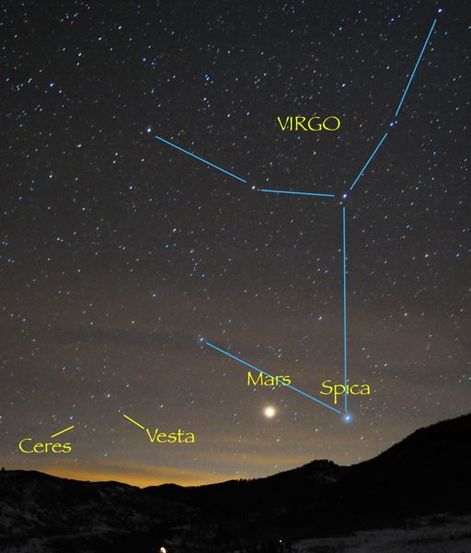



 RSS Feed
RSS Feed